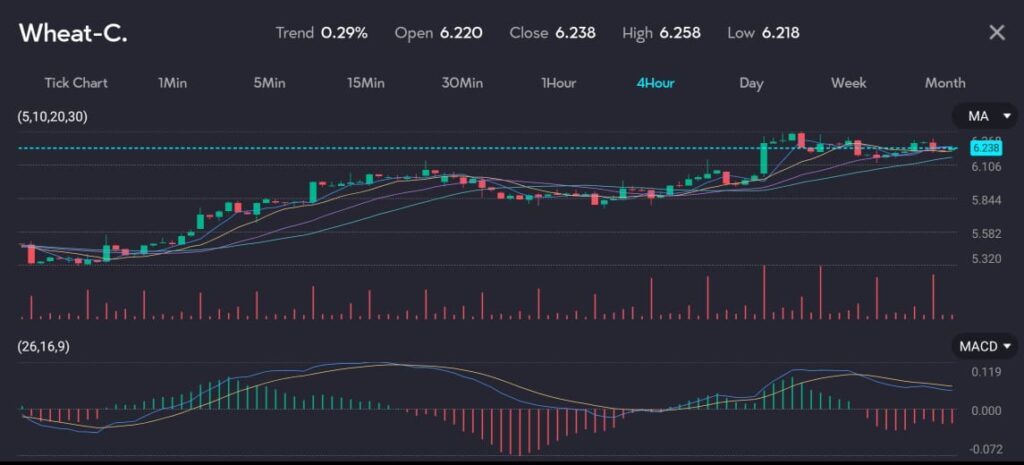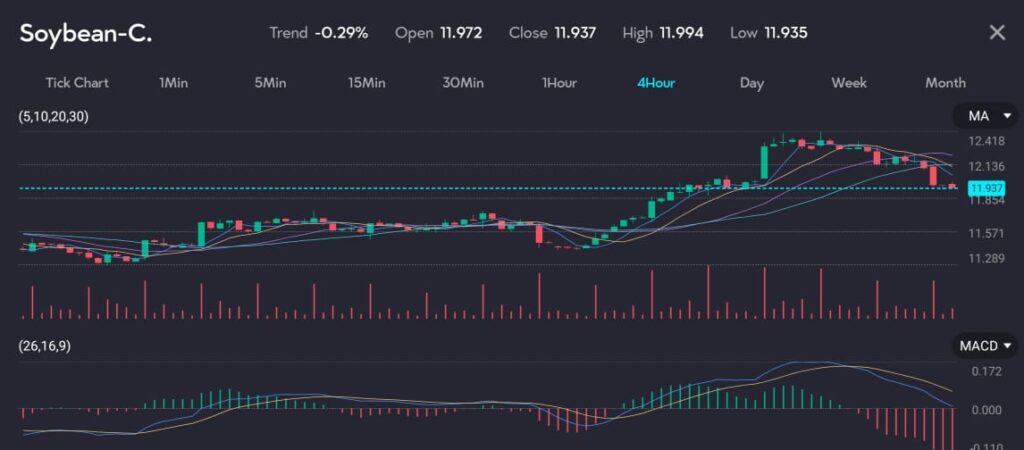Key points
- Wheat prices increased by 0.27% to $6.39-2/8 a bushel.
- Corn and soybeans also showed upward movements, recording gains of 0.22% and 0.02%, respectively.
The most-active wheat contract on the Chicago Board of Trade (CBOT) rose to $6.39-2/8 a bushel early Friday, indicating a positive start to the day. Investors might expect further price stability or slight increases as market sentiment holds firm ahead of the USDA report.

Picture: Wheat prices on the rise as seen on VT Markets app.
Corn prices climbed to $4.57-4/8 a bushel, showing resilience amidst market fluctuations. The slight increase suggests a cautious optimism among traders about demand prospects, potentially leading to steady prices in the near term.
Soybeans edged higher to $12.08-4/8 a bushel. Given the minimal increase, the market could see a stabilization in soybean prices, with potential for modest gains depending on the forthcoming USDA report details.

Picture: Soybeans ticked upwards as recorded on VT Markets app.
Regional impact from Russia on commodities
Russian agricultural regions are responding to recent frosts by replanting crops, which might temporarily disrupt wheat supply flows from one of the world’s significant producers. This situation could lead to slight upward pressure on global wheat prices.
In Brazil, specifically in the Rio Grande do Sul state, slow soybean and corn harvesting due to flooding may significantly impact local yields. With an estimated loss of 1.32 million metric tons of soybeans, global soybean supply might tighten, which could support higher soybean prices in the short term.
You might be interested: Increased farmer sales are easing bids for soybeans and corn
Argentina faces its challenges with potential yield reductions due to warm weather and dry conditions. If the Buenos Aires grain exchange reduces its soybean crop forecast further from the current 51 million metric tons, this could contribute to upward trends in soybean prices.
The ongoing strike in Argentina’s grains ports and soybean crushing plants adds another layer of complexity, potentially delaying shipments and tightening global supplies. This situation may keep soybean prices firm or slightly higher in the near term.
Weather patterns and international policy
The transition from El Nino to potentially La Nina conditions later this year suggests variability in weather patterns, which could impact agricultural productivity and commodity prices differently across regions.
Iran’s decision to halt wheat imports until March 2025, relying on domestic production, might reduce global wheat demand slightly, potentially easing some of the upward pressure on prices caused by other factors.
Global stock movements and economic indicators, such as the UK’s GDP and manufacturing output, alongside U.S. sentiment indexes, will also play roles in shaping market sentiments across various commodities, including agricultural products. The anticipation of inflation data next week adds another dimension to market speculations, possibly influencing commodity trading strategies.
Start trading now — click here to create your live VT Markets account.









